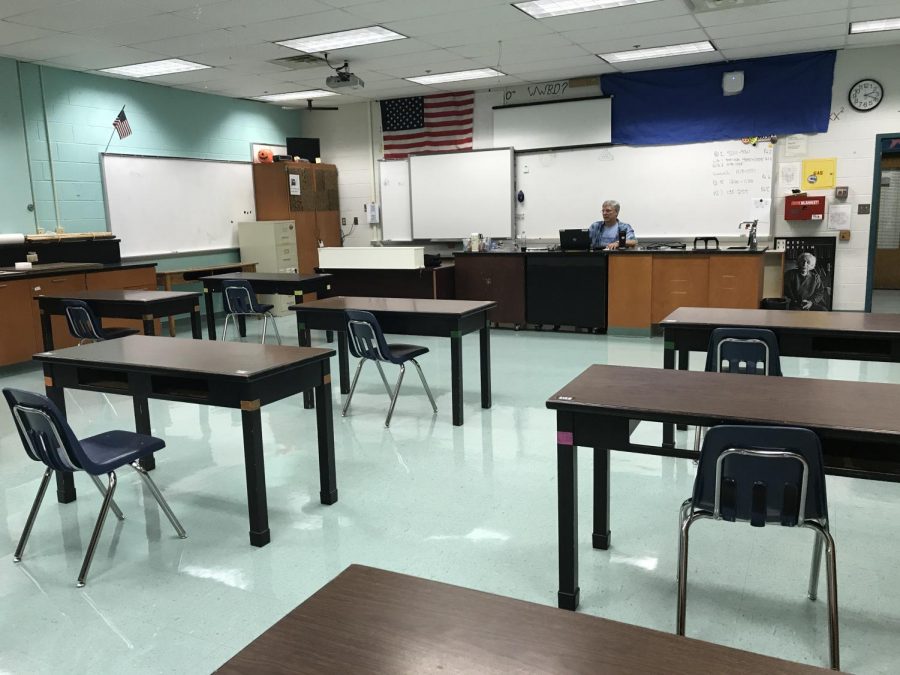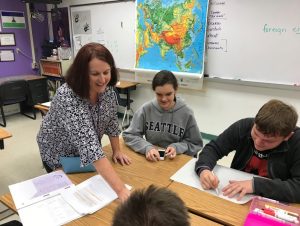Teachers adapt to virtual learning
Science teacher Patrick Matalavage demonstrates a physics problem on the white board during seventh period on October 1.
October 10, 2020
The shift to full-time online instruction has dramatically altered teachers’ plans for the new school year. Instead of being greeted with a classroom full of new and returning students, teachers sit down to face a computer screen with about 30 faceless names per class.
“It was a long process getting set up,” science teacher Patrick Matalavage said. “Fortunately, we were already familiar with Blackboard Collaborate from last spring, so it wasn’t too much of an issue.”
Before the start of school, teachers reviewed updates on grading, assessments and revised curricula. They also learned both new and familiar technology tools to help keep students engaged in the virtual classroom, such as Padlet, FlipGrid, Jamboard and Peardeck. Some of these platforms are specialized for certain classes.
“I had to re-learn Vectorworks, which is a Computer Assisted Drafting program used by theater professionals,” drama teacher Andrew Shaw said. “It can allow you to create digital 2D and 3D models of a set and even add lights to see what it would look like in real life.”
Teachers were also trained in student intervention plans, including resources for social and emotional well-being, in recognition of the fact that students may need additional academic support during the pandemic.
“We had district training in the importance of equity and inclusion, and how to keep all students engaged in learning, which is even more difficult in a virtual setting,” Shaw said. “We’re trying to keep the same atmosphere, but it’s obviously different when you aren’t seeing each other every day.”
Technology challenges include glitches in Blackboard Collaborate, problems with internet connection and miscommunication with students. Furthermore, Fairfax County Public Schools does not require students to have their cameras on during class and many prefer to keep their microphones off.
“Usually, when I’m asking a question or doing something, I can look around the room and tell by the looks on people’s faces if they know what I’m saying, or if they don’t,” Matalavage said. “But with virtual learning, it feels like it takes forever.”
However, teachers and students alike have found ways to surmount these problems and find ways to connect with each other.
“We’ve had a couple of classes bogged down by bad connections, but I’ve been impressed by how students have handled themselves,” Shaw said. “Breakout rooms have allowed students to get to know each other and interact in smaller groups, and hearing the ideas my classes came up with for expectations and norms in the virtual setting has really helped me adjust to this new normal.”
To keep in touch with the classroom setting, some teachers chose to conduct lessons at school instead of at home. While the quiet, empty halls and brief staff interactions are far from normal, they allow teachers to utilize class resources as they usually would.
“It is quiet in here, but I like using the whiteboard and having all of the equipment to demonstrate labs,” Matalavage said. “Also, I get to see a couple of the other physics teachers between classes, so we still have that camaraderie.”
In spite of the abrupt shift to virtual classes, teachers strive to recreate a familiar atmosphere for students to learn and grow. Forming these connections early on is a priority for many, as the Chantilly community prepares for a gradual return to in-person learning later in the school year.
“There’s a lot more to school than just a classroom,” Matalavage said. “Teaching is about relationships. It will take a lot of improvising in a virtual setting, but we’ll see what we can do.”







